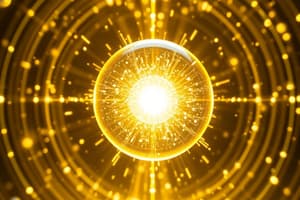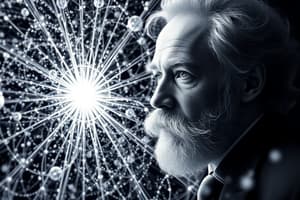Podcast
Questions and Answers
What fundamental constant did Max Planck calculate?
What fundamental constant did Max Planck calculate?
- Planck's constant (correct)
- Speed of light
- Avogadro's number
- Gravitational constant
Paul Dirac's equation predicted the existence of matter particles only.
Paul Dirac's equation predicted the existence of matter particles only.
False (B)
Who developed the Dirac equation?
Who developed the Dirac equation?
Paul Dirac
Planck assumed that atoms could only vibrate at frequencies that were whole-number multiples of a base frequency, which he named ___ .
Planck assumed that atoms could only vibrate at frequencies that were whole-number multiples of a base frequency, which he named ___ .
Match the physicist with their contribution:
Match the physicist with their contribution:
Which scientist is known for developing a staining technique that made nerve cells visible?
Which scientist is known for developing a staining technique that made nerve cells visible?
Santiago Ramón y Cajal firmly supported the reticular theory throughout his career.
Santiago Ramón y Cajal firmly supported the reticular theory throughout his career.
What major discovery did the electron microscope images in the 1950s reveal about the nervous system?
What major discovery did the electron microscope images in the 1950s reveal about the nervous system?
Cajal's drawings of the brain were almost __________ in their precision.
Cajal's drawings of the brain were almost __________ in their precision.
Match the following scientists with their respective contributions and supported theories:
Match the following scientists with their respective contributions and supported theories:
What was the major finding of Nettie Stevens's research?
What was the major finding of Nettie Stevens's research?
Nettie Stevens received widespread recognition for her work during her lifetime.
Nettie Stevens received widespread recognition for her work during her lifetime.
Which university did Nettie Stevens attend for her Biology studies?
Which university did Nettie Stevens attend for her Biology studies?
Males have both X and _____ chromosomes.
Males have both X and _____ chromosomes.
Match the following years with Nettie Stevens's milestones:
Match the following years with Nettie Stevens's milestones:
What significant change did Santiago Ramón y Cajal make to Golgi's method?
What significant change did Santiago Ramón y Cajal make to Golgi's method?
Cajal's findings supported the reticular theory of the nervous system.
Cajal's findings supported the reticular theory of the nervous system.
What term was coined by Wilhelm Waldeyer to describe a nerve cell?
What term was coined by Wilhelm Waldeyer to describe a nerve cell?
Cajal hand-drew stained nerve cells, creating some of the world's finest scientific __________.
Cajal hand-drew stained nerve cells, creating some of the world's finest scientific __________.
Match the following terms related to Cajal's work:
Match the following terms related to Cajal's work:
What does Planck's theory state about energy emission?
What does Planck's theory state about energy emission?
Planck's constant relates the energy of a photon to its momentum.
Planck's constant relates the energy of a photon to its momentum.
What is the significance of Planck's theory in modern technology?
What is the significance of Planck's theory in modern technology?
Planck's law explains the relationship between an object's temperature and the energy it emits as __________.
Planck's law explains the relationship between an object's temperature and the energy it emits as __________.
Match the following terms related to Planck's theory with their descriptions:
Match the following terms related to Planck's theory with their descriptions:
What major crop was primarily grown in the Southern US before the introduction of alternative crops by Carver?
What major crop was primarily grown in the Southern US before the introduction of alternative crops by Carver?
George Washington Carver was born after the abolition of slavery.
George Washington Carver was born after the abolition of slavery.
What degree did George Washington Carver obtain?
What degree did George Washington Carver obtain?
Carver encouraged farmers to grow ______, sweet potatoes, and soybeans to replenish soil nutrients.
Carver encouraged farmers to grow ______, sweet potatoes, and soybeans to replenish soil nutrients.
Which award did George Washington Carver receive in 1923 for his achievements?
Which award did George Washington Carver receive in 1923 for his achievements?
Match the following crops with their benefits as promoted by Carver:
Match the following crops with their benefits as promoted by Carver:
Carver worked primarily on developing synthetic fertilizers.
Carver worked primarily on developing synthetic fertilizers.
What did Carver believe was the key to unlocking freedom?
What did Carver believe was the key to unlocking freedom?
What concept did Max Planck introduce in his groundbreaking work?
What concept did Max Planck introduce in his groundbreaking work?
Max Planck was awarded the Nobel Prize in Physics in 1919 for his work on energy quanta.
Max Planck was awarded the Nobel Prize in Physics in 1919 for his work on energy quanta.
Which university did Max Planck attend for his doctoral degree?
Which university did Max Planck attend for his doctoral degree?
Max Planck's research into ________ led to his groundbreaking quantum theory.
Max Planck's research into ________ led to his groundbreaking quantum theory.
Match the following milestones with their respective years:
Match the following milestones with their respective years:
What challenge did physicists face regarding black body radiation in the 1890s?
What challenge did physicists face regarding black body radiation in the 1890s?
Planck supported Einstein's Theory of Relativity but did not create a professorship for him.
Planck supported Einstein's Theory of Relativity but did not create a professorship for him.
What did Gustav Kirchhoff define in 1859 regarding black bodies?
What did Gustav Kirchhoff define in 1859 regarding black bodies?
What significant discovery did Cajal make regarding nerve cells?
What significant discovery did Cajal make regarding nerve cells?
Cajal initially studied to become an artist before becoming a neuroscientist.
Cajal initially studied to become an artist before becoming a neuroscientist.
In which year did Cajal publish his major book on the structure of the nervous system?
In which year did Cajal publish his major book on the structure of the nervous system?
Cajal modified Golgi's staining technique to create illustrations of the ________ and nervous system.
Cajal modified Golgi's staining technique to create illustrations of the ________ and nervous system.
Match the following years with Cajal's milestones:
Match the following years with Cajal's milestones:
Which of the following advancements helped Cajal visualize individual cells effectively?
Which of the following advancements helped Cajal visualize individual cells effectively?
Cajal was awarded the Nobel Prize solely for his work on muscle tissue.
Cajal was awarded the Nobel Prize solely for his work on muscle tissue.
Which country was Santiago Ramón y Cajal born in?
Which country was Santiago Ramón y Cajal born in?
Flashcards are hidden until you start studying
Study Notes
Max Planck and Quantum Theory
- Max Planck studied how the intensity of electromagnetic radiation emitted by a black body depended on its temperature and the frequency of the radiation.
- Planck discovered that atoms could only vibrate at frequencies that were whole-number multiples of a base frequency, which he named "h" (Planck's constant)
- Planck determined that photons (light particles) behave differently contrary to classical physics.
Paul Dirac and Antimatter
- Paul Dirac, a theoretical physicist, is known for developing Dirac equation which predicted the existence of antimatter particles.
- He read Werner Heisenberg's paper on matrix mechanics which described how particles jump from one quantum state to another.
- Dirac developed a method to understand classical systems on a quantum level and created quantum field theory.
- His equation predicted "antimatter" or "positrons"—particles with identical properties to matter particles but with the opposite electrical charge.
- Dirac was appointed Lucasian Professor of Mathematics at Cambridge University and won the Nobel Prize in Physics in 1933.
The Neuron Doctrine
- The neuron doctrine replaced the reticular theory, which described a continuous nerve network.
- Electron microscope images in the 1950s revealed the existence of synapses.
- Today, the neuron doctrine is the prevailing model for how the nervous system works.
Santiago Ramón y Cajal and the Neuron Doctrine
- Cajal, a Spanish neuroscientist, was a strong supporter of the neuron doctrine.
- He meticulously drew the intricate structure of the brain using pen and ink to show how it worked.
- He won the Nobel Prize in Medicine or Physiology in 1906 with Camillo Golgi, for research on the structure of the nervous system.
Camillo Golgi and the Reticular Theory
- Golgi was a strong supporter of the reticular theory that nerve fibers were fused into a continuous network.
- He developed a staining technique using silver nitrate to make nerve cells visible under a microscope.
- Golgi's technique was further refined by Cajal who produced detailed illustrations.
Nettie Stevens and Sex Determination
- Nettie Stevens, an American biologist, discovered how sex is determined in certain insects by examining their reproductive cells.
- Her work showed that males had both X and Y chromosomes, whereas females only had X chromosomes.
- Her research linked a physical characteristic (sex) to a specific chromosome, demonstrating that sex is determined genetically.
- Her work was overshadowed until after her death.
George Washington Carver and Southern Agriculture
- George Washington Carver was a pioneering agricultural scientist who used innovative methods to improve soil and develop new crops for the Southern economy.
- He encouraged farmers to grow peanut, sweet potatoes and soybeans, which restored depleted soil nutrients.
- He developed over 400 types of products from these crops, including oils and dyes.
- Carver helped restore the South to economic stability from the devastation caused by the Civil War.
Importance of Education
- Carver believed "Education is the key to unlock the golden door of freedom."
Max Planck and Black Body Radiation
- Planck, a German physicist, revolutionized understanding of subatomic world with his quantum theory of radiation.
- He researched blackbody radiation, a phenomenon where objects emit electromagnetic radiation when heated.
- He discovered that energy was not emitted continuously, but in discrete packets or "quanta."
- Planck's research and contribution to the quantum theory earned him the Nobel Prize in Physics in 1919.
- Planck's work was crucial for the development of Einstein's theory of relativity.
Santiago Ramón y Cajal's Illustrations of the Nervous System
- Cajal modified Golgi's staining technique to allow complete visibility of nerve tissue in the brain, eye and spinal cord of birds and mammals.
- He hand-drew the stained nerve cells, producing some of the world's finest scientific illustrations.
- Because of his visual evidence, he was able to show that the nervous system is composed of billions of separate cells (neurons) that communicate electrically and chemically.
Studying That Suits You
Use AI to generate personalized quizzes and flashcards to suit your learning preferences.




